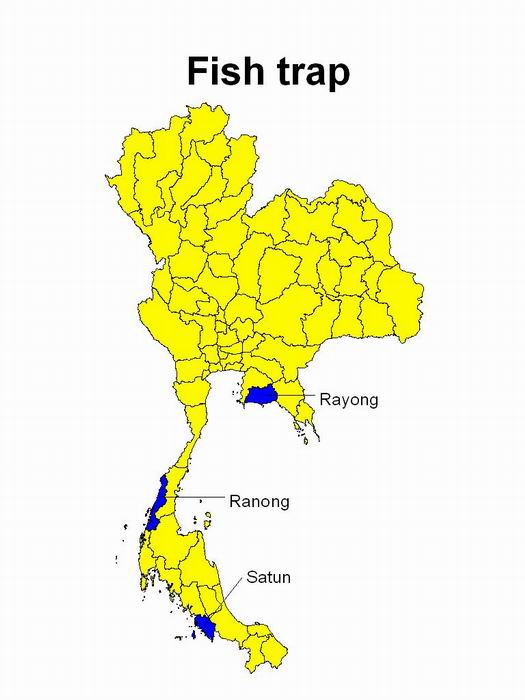Fish-trap
Fish-traps
or “pots”, as they are sometimes called, of various
shapes and sizes are operated in Thai coastal waters. According
to their shape, three main groups can be distinguished: semi-cylindrical,
rectangular and cylindrical traps. The entrance to
a trip is usually either funnel-shaped or wedge-shaped. Small
traps are about 55 cm long, 27 cm wide and 22 cm in height
or diameter. Large traps are about 200 cm long, 100
cm wide and 85 cm high.
Rattan
is traditionally the most widely used material for making
trap frames. This natural material is not only readily
available but is also strong and pliable. This last
quality makes it particularly useful for building frames
of cylindrical or semi-cylindrical traps. Wood is used
for frames of rectangular traps. Bamboo is another
commonly used material for traps.
Nowadays,
polyethylene netting is the main material for comparatively
smaller traps, whereas the mesh of larger ones is made of
steel wire. Polyethylene nets with rhomboid mesh have
mesh-size of about 4.5 – 12.01 cm. The wire netting
normally has hexagonal meshes, whose one leg (bar) is about
2.0 – 2.5 cm long.
As
many as 120 traps can be shot in the course of one operation. Each
trap has its own float and float-line, and each is shot separately
from the others. Small-sized traps are usually baited
and are hauled daily. Large traps, on the other hand,
do not contain any bait and are kept on the bottom for several
days continuously. Sometimes the float-line is made
shorter than the water depth so that it does not show on
the water surface. In this way the trap is more likely
to remain in position until its owner returns to look for
it. In such a case fisherman must know the exact setting
position of their traps, by means of the bearings of objects
on land.
The
traps which have a short float-line and submerged floats
are hauled by using a special method. When the boat
comes near the place where the trap is set, a fairly long
line, about 50 m long and with sinkers attached at both ends,
is shot to surround the float-line of the trap. The
float of the trap is large enough to be hooked by this surrounding
long line, which is than used to pull the trap to the surface.

|